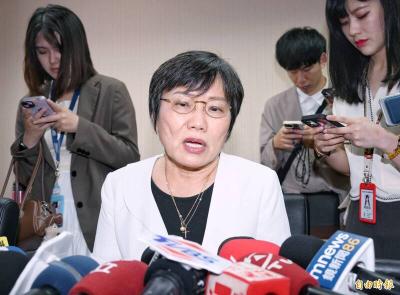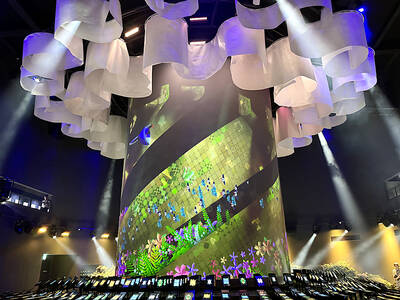The devastation wrought by Typhoon Morakot has spurred people from all walks of life to ask what they can do to help.
Dancers are no different and yesterday two dance groups announced plans to raise funds for victims.
Ballet dancer Wang Tzer-shing (王澤馨) is the organizer behind the 2009 International Ballet Star Gala at the National Theater next Saturday. She has 14 dancers from around the world arriving in Taipei, starting tomorrow, and they contacted her as soon as news of the disaster spread.
“The dancers wrote to me immediately to ask how things were in Taiwan. They all want to do something. In a short amount of time they came up with the idea of donating items like point shoes, something ballet fans would like to buy,” Wang said in a telephone interview.
“I contacted the Taiwan Red Cross and asked them to send someone to the performance, so that people will know the money is going to the Red Cross right away,” she said.
There will be tables set up in the National Theater lobby the night of the show with signed point shoes, photographs and other items donated by the dancers for sale, as well as a collection box if people just want to make a donation.
Famed dancer Sheu Fang-yi’s (?y) company, LAFA (拉芳), has decided to donate a performance, with all the proceeds going to help the people of Jialan Village (嘉蘭), Jinfeng Township (金峰), in Taitung County.
The company has a personal connection with the area — it is the home town of choreographer Bulareyaung Pagarlava (Bula, 布拉瑞揚), Sheu’s partner.
“My family are all safe, but their homes are all gone, so they are staying in different places. We didn’t find out until last night that my elder brother was alive,” Bula said. “I’m from the same village as [Aboriginal folksinger] Kimbo (胡德夫). Everyone is family in a small village. We want to let the people there know ‘you are not alone.’”
Company manager Nellie Liu (劉菡元) said the company decided to add an extra show of Ode to Joy (快樂頌) on Sunday evening, Sept. 6, at the Taipei Cultural Center, Wenshan Branch (台北市立社會教育館文山分館), where they will be performing as part of the Taipei Arts Festival.
After the shows the company will travel to Taitung to volunteer.
Meanwhile, although school hasn’t even resumed yet, Ian Chang, president of the Taipei American School (TAS) Student Government, was yesterday busy mobilizing forces to do something about the catastrophe in southern Taiwan.
On Wednesday, Chang convened 40 members of the student senate and launched an appeal to students and parents to help.
About 48 hours later, four truckloads, or about 600 boxes, of emergency material — blankets, sleeping bags, instant noodles, toiletries, sanitary equipment and scouring powder — had been gathered and was ready to be shipped south. All donations came from parents, the community and schools.
By 5pm yesterday, the 600 boxes were on their way to Kaohsiung American School, whose superintendent will personally take the donations to Namasiya Township (那瑪夏) , Kaohsiung County.
Donors ranged from small children bringing a couple of blankets or stuffed animals, to parents, who brought truckloads of items.
While the corporate sector did not participate in the TAS relief program, Chang told the Taipei Times that many TAS parents are in senior positions at big corporations, and many of them made sure that their firms donated toward relief efforts.
Chang said yesterday’s effort was just a short-term initiative, adding that plans are being made for TAS to foster schools destroyed in the south and help with reconstruction.
TAS has a long tradition of helping out in poor countries, Chang said.
“However, it’s not often that we get to help out at home,” he added.
Meanwhile, Taiwan TV stations were scheduled to hold a concert last night to raise funds for typhoon victims.

Chinese Nationalist Party (KMT) Chairman Eric Chu (朱立倫), spokeswoman Yang Chih-yu (楊智伃) and Legislator Hsieh Lung-chieh (謝龍介) would be summoned by police for questioning for leading an illegal assembly on Thursday evening last week, Minister of the Interior Liu Shyh-fang (劉世芳) said today. The three KMT officials led an assembly outside the Taipei City Prosecutors’ Office, a restricted area where public assembly is not allowed, protesting the questioning of several KMT staff and searches of KMT headquarters and offices in a recall petition forgery case. Chu, Yang and Hsieh are all suspected of contravening the Assembly and Parade Act (集會遊行法) by holding

PRAISE: Japanese visitor Takashi Kubota said the Taiwanese temple architecture images showcased in the AI Art Gallery were the most impressive displays he saw Taiwan does not have an official pavilion at the World Expo in Osaka, Japan, because of its diplomatic predicament, but the government-backed Tech World pavilion is drawing interest with its unique recreations of works by Taiwanese artists. The pavilion features an artificial intelligence (AI)-based art gallery showcasing works of famous Taiwanese artists from the Japanese colonial period using innovative technologies. Among its main simulated displays are Eastern gouache paintings by Chen Chin (陳進), Lin Yu-shan (林玉山) and Kuo Hsueh-hu (郭雪湖), who were the three young Taiwanese painters selected for the East Asian Painting exhibition in 1927. Gouache is a water-based

Taiwan would welcome the return of Honduras as a diplomatic ally if its next president decides to make such a move, Minister of Foreign Affairs Lin Chia-lung (林佳龍) said yesterday. “Of course, we would welcome Honduras if they want to restore diplomatic ties with Taiwan after their elections,” Lin said at a meeting of the legislature’s Foreign Affairs and National Defense Committee, when asked to comment on statements made by two of the three Honduran presidential candidates during the presidential campaign in the Central American country. Taiwan is paying close attention to the region as a whole in the wake of a

OFF-TARGET: More than 30,000 participants were expected to take part in the Games next month, but only 6,550 foreign and 19,400 Taiwanese athletes have registered Taipei city councilors yesterday blasted the organizers of next month’s World Masters Games over sudden timetable and venue changes, which they said have caused thousands of participants to back out of the international sporting event, among other organizational issues. They also cited visa delays and political interference by China as reasons many foreign athletes are requesting refunds for the event, to be held from May 17 to 30. Jointly organized by the Taipei and New Taipei City governments, the games have been rocked by numerous controversies since preparations began in 2020. Taipei City Councilor Lin Yen-feng (林延鳳) said yesterday that new measures by